A relation is a function if for every x in the domain there is exactly one y in the codomain
An example If A = {1, 2, 3} and B = {a, b, c}, f = {(1, a), (2, b), (3, c)}. Then f is a function from A to B.
Example: 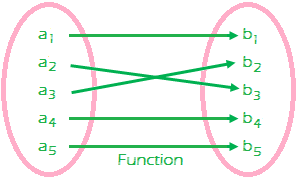 If A = {a₁, a₂, a₃, a₄, a₅} and B = {b₁, b₂, b₃, b₄, b₅} f = {(a₁, b₁) (a₂, b₃) (a₃, b₁) (a₄, b₄) (a₅, b₅)}. Then f : A → B is called function
If A = {a₁, a₂, a₃, a₄, a₅} and B = {b₁, b₂, b₃, b₄, b₅} f = {(a₁, b₁) (a₂, b₃) (a₃, b₁) (a₄, b₄) (a₅, b₅)}. Then f : A → B is called function
1. Example: 2. Example:
2. Example: Different Types of Functions:
Different Types of Functions: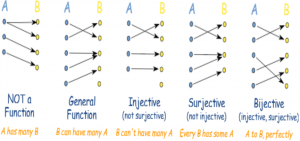 Injective (One-One Function): A function is injective if for every y in the co-domain B there is at most one x in the domain.
Injective (One-One Function): A function is injective if for every y in the co-domain B there is at most one x in the domain.
Let f : A àB A function from a set A to a set B. f is called a one-one function if and only all elements a1 and a2 in A
If f (a₁) = f (a₂) then a₁ = a₂
Equivalently: If a1 ≠ a2 then f (a1) ≠ f (a2)
Ex: If A = {1, 2, 3}, B = {a, b, c, d}, f = {(1, a), (2, b), (3, d)}. Then f : A → B is one-one
Ex: If A = {a₁, a₂, a₃, a₄, a₅} and B = {b₁, b₂, b₃, b₄, b₅} f = {(a₁, b₁) (a₂, b₄) (a₃, b₃) (a₄, b₅) (a₅, b₂)}. Then f : A → B is called one-one function
If A = {a₁, a₂, a₃, a₄, a₅} and B = {b₁, b₂, b₃, b₄, b₅} f = {(a₁, b₁) (a₂, b₄) (a₃, b₃) (a₄, b₅) (a₅, b₂)}. Then f : A → B is called one-one function
Ex: Set A is number of students and set B is number of teachers
A = {anil, ram, raju}, B = {perry, Rahul, dravid, kishor}, f = {(anil, perry), (ram, kishor), (raju, Rahul)}
Then f : AàB is called one-one function
Ex:
- One employee belongs to one organization
- One person has one passport
Many – One Function: A function not one – one function that is called many one function.
If any two or more elements of set A are connected with a single element of set B then is called many one function
EX: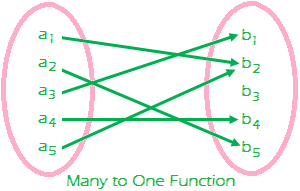 If A = {a₁, a₂, a₃, a₄, a₅} and B = {b₁, b₂, b₃, b₄, b₅}, f={(a₁, b₂), (a₂, b₅), (a₃, b₁), (a₄, b₄), (a₅, b₂)}
If A = {a₁, a₂, a₃, a₄, a₅} and B = {b₁, b₂, b₃, b₄, b₅}, f={(a₁, b₂), (a₂, b₅), (a₃, b₁), (a₄, b₄), (a₅, b₂)}
Then f : A → B is called many one function
Surjective (Onto Function): A function is surjective if for every y in the co-domain B there is at least one x in the domain.
Ex: A = {1, 2, 3}, B = {A, B}, f = {(1, b), (3, b), (2, a)}. Then f : A → B is a on to function.
Ex: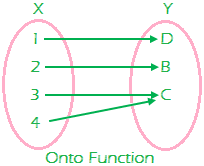 A = {1, 2, 3, 4}, B = {D, B, C} f = {(1, D), (2, B), (3, C), (4, C)}. Then f : A → B one to function
A = {1, 2, 3, 4}, B = {D, B, C} f = {(1, D), (2, B), (3, C), (4, C)}. Then f : A → B one to function
Ex: Set of A is number of students and set B is number of teachers
A = {anil, ram, raju, jenny, Amy}, B = {Mrs. Perry, Mrs. Rahul, Mrs. Kishor, Mrs. Sharma}, f = {(anil, rahul), (ram, perry), (raju, kishor), (jenny, kishor), (Amy, sharma)}. Then f : A → B is called on-to function.
Into Function: A function not on-to function is called in-to function
Ex: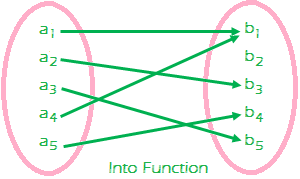 If A = {a₁, a₂, a₃, a₄, a₅} and B = {b₁, b₂, b₃, b₄, b₅} f = {(a₁, b₁) (a₂, b₃) (a₃, b₅) (a₄, b₁) (a₅, b₄)}. Then function f : A → B is called in to function.
If A = {a₁, a₂, a₃, a₄, a₅} and B = {b₁, b₂, b₃, b₄, b₅} f = {(a₁, b₁) (a₂, b₃) (a₃, b₅) (a₄, b₁) (a₅, b₄)}. Then function f : A → B is called in to function.
Bijective (One-One Onto Function): A function is bijective if for every y in the codomain there is exactly one x in the domain.
Ex: If A = {1, 2, 3}, B = {p, q, r}, f = {(1, q), (2, r), (3, p)}. Then f : A → B is one – one, onto.
Ex: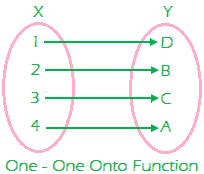 A = {1, 2, 3, 4} and B = {D, B, C, A}, f : {(1, D), (2, B), (3, C), (4, A)} then the function is called bijective
A = {1, 2, 3, 4} and B = {D, B, C, A}, f : {(1, D), (2, B), (3, C), (4, A)} then the function is called bijective
Ex: Set of A is number of students and set B is number of teachers A = {anil, ram, raju, jenny}, B = {Mrs. Perry, Mrs. Rahul, Mrs. Kishor, Mrs. Sharma}, f = {(anil, Mrs. Perry), (ram, Mrs. Rahul), (raju, Mrs. Kishor), (jenny, Mrs. Sharma)}. Then f : A → B is called one-one function.
